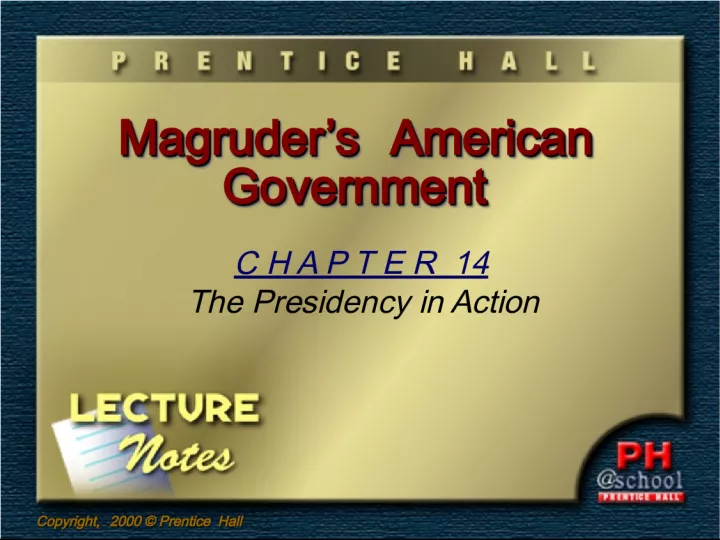"Magruder's American Government: The Presidency in Action"


An in-depth analysis of the powers and responsibilities of the President of the United States, from Section 1's examination of changing views of presidential power, to Sections 2-4 exploring the executive, diplomatic, military, legislative, and judicial powers at the President's disposal. Section 5 delves into the Executive Office of the President and the Cabinet.
- Uploaded on | 1 Views
-
 pratyush
pratyush
About "Magruder's American Government: The Presidency in Action"
PowerPoint presentation about '"Magruder's American Government: The Presidency in Action"'. This presentation describes the topic on An in-depth analysis of the powers and responsibilities of the President of the United States, from Section 1's examination of changing views of presidential power, to Sections 2-4 exploring the executive, diplomatic, military, legislative, and judicial powers at the President's disposal. Section 5 delves into the Executive Office of the President and the Cabinet.. The key topics included in this slideshow are . Download this presentation absolutely free.
Presentation Transcript
1. Copyright, 2000 © Prentice Hall Copyright, 2000 © Prentice Hall Magruder’s American Government Magruder’s American Government Magruder’s American Government Magruder’s American Government C H A P T E R 14 The Presidency in Action
2. The Presidency in Action C H A P T E R 14 The Presidency in Action SECTION 1 The Changing View of Presidential Power SECTION 2 The President’s Executive Powers SECTION 3 The Diplomatic and Military Powers SECTION 4 The Legislative and Judicial Powers SECTION 5 The Executive Office of the President and the Cabinet Chapter 14 Chapter 14
3. Chapter 14, Section 1 Chapter 14, Section 1 The Changing View of Presidential Power S E C T I O N 1 The Changing View of Presidential Power • The powers of the President have grown since 1787. • The President has a great deal of stature and power. • As American economic and social life has become more complex, people have increasingly looked to the President for leadership. • Historically, the actions of those Presidents who favored a stronger presidential role have helped expand the powers of the office.
4. The President’s Executive Powers S E C T I O N 2 The President’s Executive Powers • The President is responsible for executing federal laws whose meanings can sometimes be vague. • Because enforcing some laws can be a matter of interpretation, the President enjoys some special powers to help him execute and enforce laws. • The President can issue executive orders which have the force of law, and he can appoint subordinates or dismiss them as he chooses. Chapter 14, Section 2 Chapter 14, Section 2
5. Chapter 14, Section 3 Chapter 14, Section 3 The Diplomatic and Military Powers S E C T I O N 3 The Diplomatic and Military Powers • The President presides over relations with foreign countries; therefore, he must have certain powers that only the President may perform: (1) negotiate treaties (2) recognize the existence of foreign countries (3) appoint ambassadors and other diplomatic officers • Only Congress can declare war but the President, as commander in chief, can carry out military action without the consent of Congress.
6. The Legislative and Judicial Powers S E C T I O N 4 The Legislative and Judicial Powers • As part of the system of checks and balances, the President holds several legislative and judicial powers. • The President may recommend legislation and may veto bills passed by Congress; Congress may override a veto but rarely does so. • In the judicial field, the President may offer a reprieve or a pardon, he may commute a sentence, or he may offer amnesty. Chapter 14, Section 4 Chapter 14, Section 4
7. The Executive Office of the President and the Cabinet S E C T I O N 5 The Executive Office of the President and the Cabinet • As the President performs his responsibilities, he relies on the assistance and guidance of key advisors and agencies. • The Executive Office of the President acts as the President’s “right arm” and includes the White House Office. • A key member of this office is the Chief of Staff; other offices support the President’s foreign policy efforts, the administration of the budget, and numerous other endeavors. • The cabinet, though never mentioned in the Constitution, has evolved to play two major roles: • (1) Each cabinet member serves as head of an executive department. • (2) Collectively, the cabinet serves as an advisory body to the President. Chapter 14, Section 5 Chapter 14, Section 5